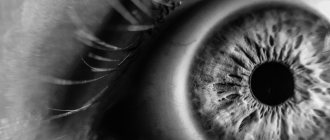Why do I see double?
In medicine, the symptom of double vision is called diplopia. It is characterized by incorrect perception of an object, in which a person sees two images at once instead of one. The picture can be duplicated both horizontally and vertically. In the first case, the images are side by side, and in the second, they appear one above the other. Normally, a healthy person perceives the world around him using binocular vision.
From each eye, certain signals are sent to the brain, which are then superimposed on each other, which allows you to perceive a complete stereoscopic image. With diplopia, the brain receives an incorrect signal, so it cannot correctly compare information. As a result, a person observes two images at once instead of one. The symptom is often accompanied by dizziness, severe headache, and in some severe cases, attacks of nausea.
In addition, a person often experiences difficulties when moving, since it is difficult for him to navigate in space due to incorrect assessment of distances to objects. Some people confuse diplopia with blurred vision. However, in the second case, we are talking more about blurring the contours of objects and the appearance of shadows. Fogging does not cause two overlapping images.
Double vision may appear periodically, for example, with visual fatigue, a sharp turn of the head or direction of gaze at a certain angle. In some cases it is observed systematically. Sometimes a symptom occurs one-time, for example, during alcohol intoxication or taking certain medications.
If a person notices that he has double vision for a long period of time, he should seek help from a doctor.
In order to get rid of this unpleasant symptom, you need to determine the cause of its occurrence. A comprehensive examination will be required, since diplopia can occur due to a variety of factors: pathologies of the visual and central nervous system, as well as various diseases.
Symptoms of double vision:
- A person sees two duplicate images of one object (not to be confused with blurriness and unclear perception of contours);
- Images appear double vertically or horizontally;
- There is dizziness and headache;
- With severe double vision, attacks of nausea are possible.
3.Diagnostics of double vision
If for some unknown reason you begin to see double, you should immediately consult a doctor. With so many potentially serious causes of double vision, you need to find the cause as soon as possible.
Your doctor will likely use a variety of techniques to determine the cause of double vision. Blood tests, a physical examination, and possibly imaging tests such as a CT scan or MRI are the most commonly used.
General information is very important for diagnosing double vision. Here are some questions your doctor might ask:
- When did the double vision start?
- Have you hit your head, fallen, or been unconscious?
- Have you ever been in an accident?
- Does double vision get worse towards the end of the day or when you are tired?
- Do you have any other symptoms besides double vision?
- Do you have a habit of tilting your head to the side when you look somewhere?
Now focus your vision on some stationary object in your field of vision, for example, a window or a tree behind it.
- Are the two objects that appear as a result of double vision near each other? Or is one higher than the other? Or maybe they are located slightly diagonally? Are any of them larger or smaller?
- Are both images clear? Or is one clear and the other blurry?
- Close one eye and then open it and close the other. Does double vision go away when you look with one eye?
- Imagine that you are looking at a watch dial. Move your eyes in a circle, according to the numbers. Does double vision get worse at certain clock positions? Or is it getting better in some area?
- Tilt your head to the right and then to the left. Does double vision get worse/better in any of these positions?
About our clinic Chistye Prudy metro station Medintercom page!
What are the reasons for dizziness and double vision?
Depending on the symptoms of the disease, it is customary to distinguish between monocular and binocular types of diplopia.
Monocular diplopia
In this case, double vision persists, even if you look with only one eye and close the other. Often this process is associated with damage to the cornea or lens, as a result of which the image is projected twice onto the retina. In addition, it can occur with various inflammatory eye diseases, as well as cataracts, astigmatism and dry keratitis. Monocular double vision is less common than binocular double vision and has characteristic symptoms, so it can be diagnosed quite easily and quickly by specialists.
What eye diseases lead to monocular diplopia?
- Problems associated with the cornea: scarring, infectious diseases (keratitis), keratoconus (thinning and curvature of the cornea), pterygium (pterygium in the area of the inner canthus).
- Cataract. The most common cause of double vision is clouding of the lens. In this case, the symptom is especially pronounced when reading. Lens luxation. This pathology leads to visual distortions and double vision. In this case, surgical treatment is usually required.
- High degree of astigmatism.
- Dry keratitis. Drying of the cornea sometimes leads to monocular double vision. In this case, the use of special moisturizing drops is indicated.
Binocular diplopia
The most common is binocular diplopia, in which a person sees several images of one object only if he looks with both eyes at once. As a rule, if you close one eye, the double vision immediately disappears. Binocular double vision can occur due to various visual pathologies, one of which is strabismus. In this case, the patient experiences a deviation in the visual axis of one of the eyes, caused by weakening of the muscles that are responsible for the correct movement of the eyeball. If the oblique muscles do not work correctly, vertical double vision occurs, and if the rectus muscles work abnormally, horizontal double vision occurs. Many people are interested in what disease can cause binocular diplopia. Let's look at the common causes of this double vision.
Why can you see double?
- Strabismus;
- Diseases of the thyroid gland, which contribute to the weakening of the motor eye muscles;
- Hypertension and other vascular disorders - a sharp change in blood pressure or cerebral circulatory disorders (stroke);
- Diabetes mellitus - can cause damage to the nerves responsible for proper eye movement;
- Myasthenia gravis is weakening and wasting of the eye muscles due to a neuromuscular autoimmune disease;
- Multiple sclerosis is a pathology in the functioning of the central nervous system (CNS), in which the cells of a person’s spinal cord and brain are “attacked” by his immune system.
- An aneurysm is a pathology that occurs when part of an artery (blood vessel) dissects;
- Brain injuries (including concussion);
- Feverish conditions caused by various viral infections;
- Eye surgeries.
The image also doubles in cases of severe intoxication of the body caused by excessive alcohol consumption or nitrate poisoning. In addition, the symptom may occur due to taking certain medications (anticonvulsants, antiepileptics) and visual fatigue. In these situations, diplopia is temporary and goes away on its own over time.
Why do I see double in contact lenses?
It happens that when putting on contact correction products, you feel dizzy and see double. If such a symptom occurs when you first put it on, it is likely that the problem is related to the incorrect selection of optical products. Before purchasing lenses, you should definitely undergo an examination of the visual system in an ophthalmologist’s office to select diopters, curvature and other optical parameters.
If ghosting occurs when using scheduled replacement lenses after cleaning, the problem may be due to a change in their structure. For example, when left in a solution for a long time (more than 3 days), optical products can be chemically modified and partially change their parameters. In this case, you will have to replace the optics with a new one. Remember that when using scheduled replacement models (two weeks or more), special attention should be paid to the rules of care. If you do not want or for some reason cannot systematically clean your lenses, we recommend choosing one-day lenses, for example, 1-Day Acuvue TruEye or Alcon Dailies Total 1. Models designed for daily replacement are the most practical, simple and safe to use.
If you feel like you are seeing double vision while wearing contact correction devices, make sure that it is actually diplopia and not blurred outlines of objects, lack of contrast, or other symptoms of blurred vision. In any case, you should consult an ophthalmologist.
Eyes and coronavirus infection
According to statistics, about 30% of patients who recovered from COVID-19 complained of discomfort in the eyes and various visual disorders. In most cases, this problem persisted for up to 2 weeks.
Conjunctivitis during coronavirus infection develops due to the penetration of viral particles through the mucous membranes of the eyes, which are the “entry gate” for the virus. Therefore, the general recommendations for preventing the spread of COVID-19 say: do not touch your face with dirty hands , or rub your eyes. The best means of protecting your eyes during this infection are glasses that fit tightly to your face, as well as careful hand hygiene.
Often, signs of viral conjunctivitis appear several days before the body’s acute immune reaction in the form of an increase in body temperature. After this, general weakness, muscle pain, and impaired sense of smell occur.
The general clinical picture of eye damage includes: redness of the eyes, photophobia, lacrimation, pain in the eyes, a feeling of dryness, a feeling of speck, itching, burning, blurred vision, decreased visual acuity. Most often, coronavirus infection affects both eyes and the clinical picture develops in the same way in both eyes.
Scientists have also proven that coronavirus infection lives on eyelids and eyelashes for up to 2 days. An interesting fact is that patients complaining of pain, redness and discomfort in the eyes in combination with loss of smell were less likely to have severe forms of COVID-19, unlike those patients who did not have these signs. Their illness was milder, without complications such as pneumonia and heart failure.
The risk group includes young children and elderly people who do not always responsibly follow the rules of personal hygiene. Carried away by an interesting game, children often touch their faces and rub their eyes. There is also a high probability of getting sick for those who, due to the nature of their work, are forced to come into contact with a large number of people. With a strong cough or sneeze, the likelihood of spreading infected saliva over several meters increases.
The mucous membrane of the eye suffers from the penetration of coronavirus infection into it - a powerful inflammatory process develops in it, which can affect the cornea and retina.
One of the ways to prevent coronavirus infection from entering the eyes is to wash the eye mucosa with an isotonic solution of sodium chloride (Okusalin drops). At the first signs of obvious inflammation of the eyes, you should immediately consult an ophthalmologist.
Follow the rules of personal hygiene, take care of yourself and be healthy!









